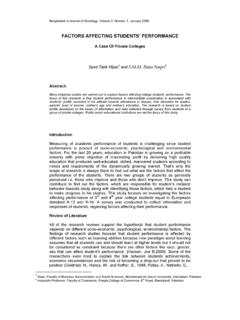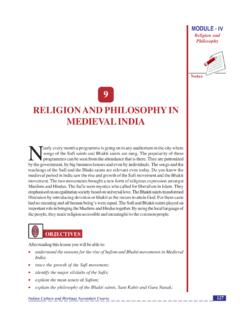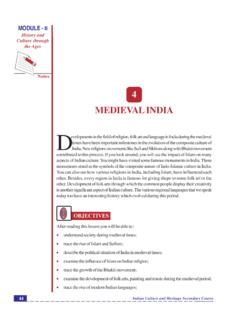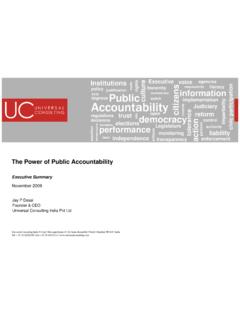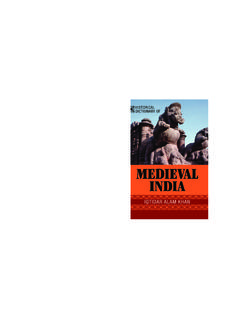Transcription of Cultural Diversity, Religious Syncretism and People of ...
1 Cultural diversity , Religious Syncretism and People of india : An Anthropological Interpretation . Abstract Ethnic origins, religions, and languages are the major sources of Cultural diversity . india is a country incredible for its diversity ; biological and Cultural . However, the process of synthesis and integration has been extensively at work in most parts of india . Indeed ethnic identities and even the culture traits of Indian People have never been frozen in time or in space, they have been in state of flux. Though each group or community has a distinctive identity and ethos of its own, it does not exist in a social vacuum. Rather, it forms part of an extended and dynamic network. The sharing of space, regional ethos and Cultural traits cut across ethnic and sectarian differences and bind the People together. Thus, we witness a firm balancing between Cultural diversity and Syncretism pervading the foundation of Indian civilization. Indeed by extension, such Cultural phenomena are observable, to lesser or greater degree, in the entire sub continental civilizational arena.
2 The preexisting sub continental - civilizational continuum historically includes and encompasses ethnic diversity and admixture, linguistic heterogeneity as well as fusion, as well as synthesis in customs, behavioural patterns, beliefs and rituals. In the present era of growing Cultural condensation, Syncretism -synthesis is fast emerging as a prevailing event. This paper explores, by discussing ethnographic examples from different parts of india and beyond, the multi-dimensional and many layered contexts of reciprocally shared Cultural realms and inter- Religious and synthesized Cultural formations, including common Religious observances. Cases pertaining to adherents of major and minor religions, including Dalits and Adivasis are dealt with to determine the major trends in the sphere of Syncretism . This paper is an attempt at building a broad perspective of diversity , convergence and dissemination of Cultural practices and Religious beliefs, highlighting the patterns and processes through which religions and cultures on both sides have been creatively blended.
3 I. Ethnic origins, religions, and languages are the major sources of Cultural diversity . india is a country incredible for its diversity , biological and Cultural . It is the natural resources that attracted to the subcontinent many streams of People at different times, from different directions; bringing together a great diversity of human genes and human cultures. Thus the bulk of the Indian population represents racial admixture in varying degrees. Unlike several other lands where the dominant human cultures have tended to absorb or eliminate others, in india the tendency has been to nurture diversity , which has been favoured by the diversity of the country's ecological regimes [Gadgil and Guha, 1992]. Powerful kingdoms and enumerable dynasties, contributed to the shaping of india 's Cultural regions. An important source of diversity among the People of india is the Cultural identity of particular communities and regions. Despite maintaining distinct identities several jatis, sects, and communities have organic links with other segments of the population of the region, which develops a Cultural persona over time.
4 Indian civilization has had a pluralistic character from the start. The pluralistic and composite ethos of Indian civilization, which began evolving during the Vedic period, was supplemented by the rise of Buddhism and Jainism, and was further reinforced during the early medieval period, which witnessed the early zenith in the Bhakti Movement. This composite tradition attained primacy during the late medieval period. Linguistic and philological evidences demonstrate the incorporation and adaptation of regional features into the mainstream of Sanskritic culture distinctly. Certain kinds of echo formations, which are characteristic of the Austric family of languages, found their way into the Indo-Aryan speeches. The presence of non-Aryan elements, especially Proto-Dravidian, in vocabulary, syntax and phoenetics in . Superintending Anthropologist ( Cultural ), Anthropological Survey of india , 27, Jawaharlal Nehru Road, Kolkata- 700016. Email: Vedic Sanskrit is now fairly well established. The later Vedic texts indicate an even greater admixture of non-Aryan words.
5 The Vedic society was internally differentiated and it was pluralistic. It was a synthesis of Aryan and non-Aryan, including tribal elements. Since its very beginning Hinduism has been a "mosaic of distinct cults, deities, sects and ideas . Most records reveal that totemic deities such as fish, tortoise and boar were made into incarnations of Vishnu. Shiva was formed by a fusion of the Vedic Rudra with some non-Aryan deity. Shiva in its tribal and folk form is observable in several parts of peninsular india , including plains of northeast india , particularly in Assam -north-Bengal regions. Enough material exists which confirm the fact that Brahmanism immersed the deities of tribespeople and low-castes'. The popularity of the saga of Jagannath cult in Orissa and that of Viththala in Maharashtra testify this. Similarly, serpent worship and phallus worship, which later found their way into classical Hinduism, were taken over from local communities. Unorthodox sects and cults, such as Shakta and the Tantric tradition, incorporated several esoteric features from indigenous, including tribal cultures (Momin 1996, Singh 2003, Das 2003).
6 Thus, some interrelated critical foundations of unity may be delineated at the pan-Indian level. We may categorize them first as the Sanskritic Hinduism at the social structural levels and through a system of pilgrimage centres. Then we may consider a composite Cultural tradition born out of the protracted interaction and exchange between Hindus and Muslims and adherents of other faiths through the length and breadth of the country. In this context one may notice social reforms and humanistic tendency as exemplified in the Sufi and Bhakti Movements. The secular-democratic philosophy, which is enshrined in the Constitution of the country and a Gandhian vision of Indianness, which was well founded during freedom movement, are manifestation and demonstration of our composite culture in modern india . Since the late medieval period india witnessed a creative synthesis of Hindu and Islamic civilizations and thus grew a composite tradition, a pluralistic synthesis of the Indo-Islamic tradition including inter-faith convergence.
7 There are two interrelated dimensions of the Indo- Islamic tradition. On the one hand, it manifested itself in syncretistic traditions of music, art, literature and architecture, and on the other, it found expression in folklore, dress patterns, food habits, names and surnames. If we turn to rural landscape we discover the distribution of material traits at the regional level indicating a certain complementarities in that it is marked by both local differentiation and interpenetration. Not only that a cluster or complex of material traits at the regional level unites different sections and communities (Bose, 1961), different communities have brought with them often innovations into regions of their adoption and internalized them effectively (Momin 1996, Singh 1985, 1994), though a proper mapping of same is unlikely to be accomplished shortly. This phenomenon is seldom subjected to a critical examination in a diachronic framework anywhere. Language is an important attribute of a population, and has great relevance and significance in a multi-lingual and multi-ethnic country like india .
8 The language literature generated by census over the last more than one hundred years has thrown much light on the ethnic and the linguistic characteristics of the population. The total number of mother tongues returned in 1961 and 1971 censuses was around 3,000, in 1981 around 7,000 and in 1991, it was more than 10,000. Tribal languages cannot be dismissed as dialects; many of them have a growing literature and at least two have their own scripts. Their multiplicity is baffling. Consider the case of Nagaland, formerly a district but now a State. It has as many as twenty different languages. The Kohima station of All india Radio used to broadcast in twenty-five languages, besides Nagamese, the lingua-franka. The pan-Indian, civilizational dimension of Cultural pluralism and Syncretism encompasses ethnic diversity and admixture, linguistic heterogeneity as well as fusion, and variations as well as synthesis in customs, behavioural patterns, beliefs and rituals. The process of synthesis and integration has been extensively at work at the regional level (Das 2003).
9 Though each group or community has a distinctive identity and ethos of its own, it does not exist in a social vacuum. Rather, it forms part of an extended and dynamic network. Often, interaction, exchange and integration characterize inter-community relations. The sharing of space, regional ethos and Cultural traits cut across religions and sectarian differences and bind the local People together. It is now revealed and established more vividly those Cultural and Religious practices in diverse eco- Cultural zones of india have historically converged and People shared common traditions extensively. Thus, we witness a fine balancing between pluralism and Syncretism pervading the base of Indian culture. While enough literature exists on this aspect of Cultural manifestation in historical writings, not much is known about the Religious Syncretism and its stretch in contemporary india . II. Hardly a central theory in anthropology, Syncretism has recently re-emerged as a valuable tool for understanding the complex dynamics of ethnicity, interconnectedness and post- modernism.
10 In the present era of increasing Cultural condensation, Syncretism is a prevailing event. The sociologists and social anthropologists have thrown much light on the variety of Religious forms through their studies of belief systems, rituals, symbols and meaning all over the world but they have not paid adequate attention to the phenomenon of Syncretism , though we find a few exceptions (Raymond Firth, 1970:87). In anthropological literature the Cargo cult has been described as a form of Syncretism . Cargo cults are essentially syncretistic, blending the Christian doctrine with "aboriginal beliefs" (Worsley, 1990). Anthropologists have also included the blend of African, Native American, and Roman Catholic saints and deities in Caribbean "voodoo" cults as instances of Syncretism . Though the process of Syncretism provides an independent field of study, it was nevertheless ignored by the anthropologists and when discussed it was imperfectly included within "the study of acculturation" (Kottak 1991:407).
